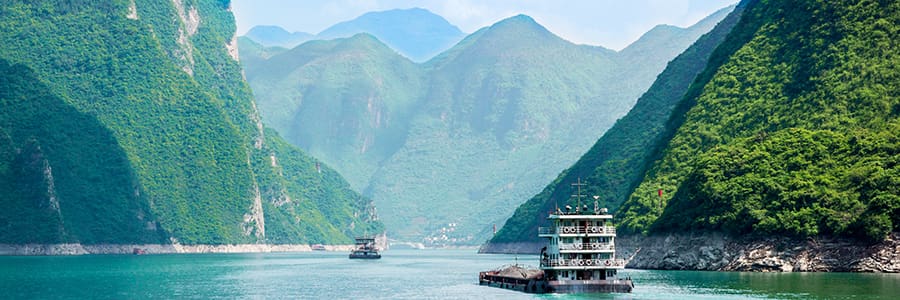
About The Yangtze River
The Chinese never refer to the river as the Yangtze; they call the river by its full name, “Chang Jiang,” or “Long River.”
It is the longest river in Asia and the third-longest in the world, its source shrouded in mystery until modern times, mistakenly named the “Yangtze” by Christian missionaries who were unaware that for the Chinese the name only refers to the lower part of the river, from Nanjing to the river mouth at Shanghai. 3,964 miles long, the river also has many local names as it makes its way eastward across the entire width of China, historically dividing north and south.
A cruise along this ancient water, closed to the outside world for centuries, is a once-in-a-lifetime journey. On the water, you’ll slip into the slower pace of life that has been lived here for centuries, passing towns and villages dotted with temples and pagodas, stopping to browse the local markets for silks and carvings. A highlight of every cruise features the most dramatic part of the river, the Three Gorges region, a stretch of approximately 120 miles boasting stunning vistas of misty mountains, sheer gorges, and verdant bamboo groves.
The sheer size of the Yangtze means there are plenty of options for cruise enthusiasts, with all the major river cruise lines including the Yangtze on their China tours. The main cruise season runs April through October, with the weather being optimal in the spring and fall.
Yangtze River Stats
Length: 3,950 miles
Depth: Up to 100 feet
Source: Tanggula Mountains, Qinghai, China
Mouth: East China Sea near Shanghai
Locks: 7
Countries: China
Learn More About the Yangtze River of Asia
The Yangtze River, known as Chang Jiang (长江) in Mandarin, is one of the most iconic and influential rivers in the world. Stretching over 6,300 kilometers (3,915 miles) across the heart of China, it is the longest river in Asia and the third-longest in the world, trailing only the Nile and the Amazon. The Yangtze River has played a pivotal role in shaping China’s history, culture, and economy for thousands of years, earning its nickname as “China’s Sorrow” and “Mother River.”
Geography and Course
The Yangtze River originates from the Tanggula Mountains on the Qinghai-Tibet Plateau, where it is fed by glaciers and high-altitude springs. It flows eastward through Qinghai, Tibet, Sichuan, Yunnan, Chongqing, Hubei, Hunan, Jiangxi, Anhui, and Jiangsu provinces before emptying into the East China Sea near Shanghai. The river’s course meanders through diverse landscapes, from rugged mountain terrain to fertile plains and urban centers.
Historical Significance
The Yangtze River has been a cradle of Chinese civilization for millennia. Archaeological discoveries in the river’s basin date human activity in the region back more than 27,000 years. The ancient cultures that flourished along the Yangtze, such as the Shang and Zhou dynasties, laid the foundation for Chinese civilization. One of the most remarkable aspects of the Yangtze’s historical significance is its role as a transportation artery. The river’s wide expanse allowed for the development of waterborne commerce, facilitating trade and cultural exchange between regions along its banks. The Grand Canal, an extensive man-made waterway, connected the Yangtze to the Yellow River, creating a vital trade network in ancient China.
Economic Importance
Today, the Yangtze River continues to be a lifeline for China’s economy. The river basin is home to around 40% of China’s population and contributes over 40% of the country’s GDP. Its rich alluvial plains support agriculture, with rice and wheat as major crops. Moreover, the river serves as a vital transportation route, facilitating the movement of goods and resources to and from China’s interior. The Three Gorges Dam, completed in 2006, is one of the most significant engineering feats on the Yangtze River. This colossal hydroelectric power station not only generates electricity but also regulates the flow of the river, reducing the risk of flooding downstream. It has, however, been a subject of controversy due to its environmental and social impacts.
Ecological Diversity
The Yangtze River basin is renowned for its ecological diversity. It is home to many unique species, including the critically endangered Chinese river dolphin, or Baiji, which was declared functionally extinct in the early 21st century. The river also sustains numerous other species of fish, including the Chinese sturgeon and the Yangtze giant softshell turtle. However, the ecological health of the Yangtze River has been challenged by pollution, habitat destruction, and overfishing. Conservation efforts have been initiated to protect the river’s biodiversity, with a focus on restoring habitats and regulating industrial pollution.
Cultural Significance
The Yangtze River has inspired countless poems, songs, and artworks throughout Chinese history. It is often depicted as a symbol of China’s natural beauty and cultural heritage. The river’s iconic landscapes, such as the Three Gorges, have been the subject of artistic expression for centuries. Cultural traditions along the Yangtze are diverse, reflecting the unique identities of the regions it passes through. From the spicy cuisine of Sichuan to the traditional tea culture of Jiangsu, the Yangtze River has contributed to a rich tapestry of cultural experiences.
Challenges and Conservation
Despite its historical and economic importance, the Yangtze River faces numerous challenges in the 21st century. Rapid urbanization and industrialization have led to pollution, habitat loss, and the alteration of natural flow patterns. The Three Gorges Dam, while providing benefits, has also raised concerns about its environmental and social impacts. Conservation efforts are underway to address these issues. Initiatives aim to restore the river’s ecological balance, mitigate pollution, and preserve cultural heritage sites. Sustainable development practices are being promoted to balance economic growth with environmental protection.
